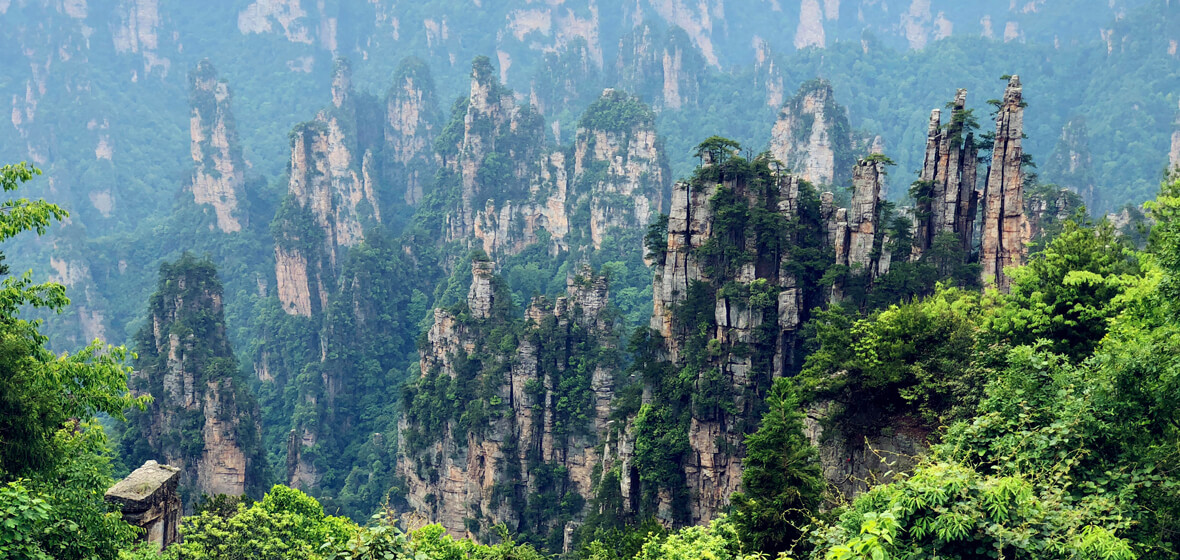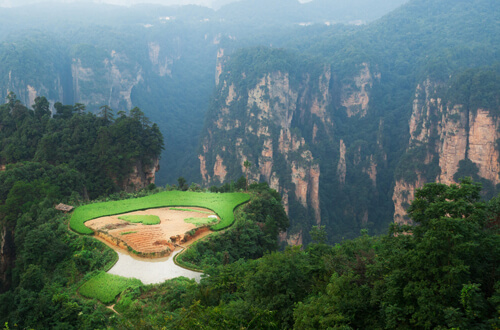Tianzi Mountain

Formerly known as Qingyan Mountain, it was renamed Tianzi Mountain after the local Tujia tribe leader Xiang Dakun, who claimed to be the Tianzi or Son of Heaven, the traditional epithet of the Chinese Emperor. Xiang Dakun led a farmers’ revolt against the government in the 14th century. He was defeated in battle and fell into the Shentang Gorge. The park stretches for nearly forty kilometers and has a total area of 64 square kilometers. The Kunlun Peak with an elevation of 1262.5 meters (4,142 feet) is the highest in the area, hence called "the Monarch of the Peak Forest". Due to the height, visitors can have a near bird's eye view of the surroundings below and even the expanse of the forest on a fine day. This mountain is particularly well known for its atmospheric mists and clouds that obscure the base of the highest mountain peaks and give the impression of “floating” rocks. These peaks inspired James Cameron’s 2009 blockbuster, Avatar.
Tianzi Mountain is the product of millions of years of sedimentary rock erosion. Its ancient sandstone peaks, as old as 300 million years, have been slowly carved out by water and wind. Tianzi Mountain offers different scenes during different seasons, all of which are equally striking and magical even: the Sea of Clouds, the Radiance of the Moonlight, Rays of Sunshine, and the Snow in Winter.
- Chinese Name: 天子山 Tiān zǐ shān
- Duration: 2-3 hours
- Entrance fee: included in the entrance fare of Zhangjiajie National Forest Park
- Opening hours: 7:00-18:00
- Address: in Zhangjiajie National Forest Park. Please refer to the guide map
- Best time to visit: Spring and Fall
- How to get there: Take a coach from Zhangjiajie Coach Station. The trip is about 1.5 hours or you can get the direct coach to Tianzishan Scenic Area.
Highlights at Tianzi Mountain
Tianzi Mountain is in the hinterland of Wulingyuan, towering above its surroundings. When looking into the distance from the main peak of Tianzi Mountain, tourists can have an awe-inspiring panoramic view. All the scenic areas can be seen in layers at that point. Tianzi Mountain gives a mysterious and quiet feeling, with the bizarre rock forests that make it memorable. Countless halberd (combined spear and battle-ax) like stone peaks are standing in the area, like military troops with an imposing manner. Tourists usually marvel at the impressive sight. The waves of clouds, the glory of the moon, the sunglow as the sun rises, and the snowfall in the winter are the four wonders of Tianzi Mountain.
The clouds on the mountains are infinitely changing, and their manners are numerous. Sometimes they are like the tumbling rivers and seas, and at other times they are like a light gauze. At sunrise or sunset, Tianzi Mountain blazes in the glow.
1. Shentang Gorge (神堂湾 shén táng wān)
This gorge lies in the middle of a remote open valley surrounded by soaring precipices on all sides, with water so deep that its depth is unknown. The bottom of the gorge is veiled in mists and clouds all day, adding to its mysteriousness. In the center of the bottom lies a fathomless green pond. Looking down the pond from the mouth of the gorge, one can't help shivering. What's peculiar is that visitors can hear sounds of gongs and drums, neighs of battle steeds, and shouts of men echoing from the bottom. Nobody can give a reasonable answer to this mystery. It is said that Xiang Dakun jumped into the gorge after his army was defeated by the emperor.
 Field up in the Air
Field up in the Air
2. Field up in the Air (空中田园 kōng zhōng tián yuán)
Above more than 1000 meters of cliffs, there is the 3-hectare sloped trapezoidal field. The field is surrounded by tall trees. Tourists would get the sense they are traveling through a Chinese landscape painting. Ascend to the Fields up in the Air, the clouds and the breeze gives an awareness that you are standing in heaven.
3. Imperial Emperor's Writing Brush Peaks (御笔峰 yù bǐ fēng)
Three peaks, which are pointed to the sky and covered by pine trees, resemble a Chinese brush. Local lore has it that the gods painted Zhangjiajie, expressing the incredible beauty of the region.
4.Fairy Spreading Flowers(仙女散花 xiān nǚ sàn huā)
The peak that resembles a fairy spreading flowers is opposite the Imperial Emperor's Writing Brush Peaks. The rolling clouds isolate numerous cliffs into islands. The gorgeous-lady-like peak is standing up in the air. The fog driven by the wind adds more charm to the peak. Upon closer inspection, she is wearing a flower. One hand is holding a lovely basket and the other hand is spreading flowers into the secular world. The green bushes on the top and the flowers at the middle and foot of the peak are typically beautiful at the end of spring.
5. Fairy Bridge (仙人桥 xiān rén qiáo)
Fairy Bridge, which is 26 meters (85ft) long, 1.5 meters wide, and 2 meters thick, is made of red sandstone. The bridge rises approximately 67 meters (220 ft) above the bottom of the peaks. Like a rainbow, the bridge connects two peaks. Tall pinus hwangshanensis (Huangshan pines) and rhododendron grow at both ends. There are also natural steps on the east end of the bridge, however, the bridge is not for the faint-hearted as it is so close to an abyss.
6.Tianzi Pavilion(天子阁 tiān zǐ gé)
Built in 1995, the Tianzi Pavilion offers a panoramic spectacle of Tianzi Mountain. The six-story Pavilion is 30 meters high. The vintage building has multiple roofs that range over the whole pavilion. It has reinforced concrete column bases, stone railings, granite floors, Chinese catalpa wooden doors and windows as well as golden glazed tiles. The pavilion has cliffs on its three sides. The mountains and peaks are all easily visible at a glance.
7. The Stage of Appointing Commander (点将台 diǎn jiāng tái)
An observation platform is divided into three levels and surrounded by iron railings. There are many peaks in the valley, and more than a dozen peaks and columns that look like the parade of officers and soldiers waiting for dispatching.
8. He Long Park (贺龙公园 hè lóng gōng yuán)
He Long (pronounced Ho Long) is an important Chinese military leader. He was awarded the rank of Marshal in 1955. Marshal He Long was born in Sangzhi County at the foot of Tianzi Mountain in 1896. This park is dedicated to him. A gigantic bronze statue of Marshal He can be found in the park. There is an exhibition hall in the park dedicated to Marshal He. A series of life-size wax figures and memorabilia bring to life the major events in Marshall He's life. From the platform in the park, you can view the “West Sea” which includes numerous peaks standing in different shapes and poses, covered with lush vegetation.
9. Cable car
The cable car is 2091 meters (6858ft) long and takes 6 minutes for the ride. The cable car will take you to Imperial Emperor's Writing Brush Peaks and Fairy Spreading Flowers. You’ll have a spectacular view during the ride.
Tips for visiting the Tianzi Mountain:
- Wear comfortable shoes as there is a lot of walking.
- We strongly recommend that you join a tour group, or at least hire a guide.
- Take the cable car up to the top, the views from the ride are fantastic.
- For those fit enough, it’s a two-hour downhill hike to Suoxi Valley which offers more viewing platforms on the way down.
- There is a McDonald's up the mountain, but it is advisable to pack some snacks and bring water.
Drop us a line and we'll connect you with the top China expert in no time!